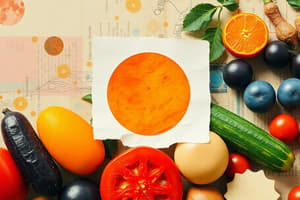Podcast
Questions and Answers
Which of the following statements accurately describes the role of vitamins in the body?
Which of the following statements accurately describes the role of vitamins in the body?
- Vitamins are not important for energy-related reactions.
- Vitamins are primarily synthesized in large quantities within the body to support growth and health.
- Vitamins are needed in large amounts and are the primary source of energy for metabolic reactions.
- Vitamins are essential for the use of proteins and carbohydrates in the diet. (correct)
Which of the following is a key characteristic of fat-soluble vitamins?
Which of the following is a key characteristic of fat-soluble vitamins?
- They are absorbed with water and require frequent replenishment.
- They are not absorbed with dietary lipids, and can't be stored.
- They are stored in the body, increasing the risk of toxicity if consumed in high amounts. (correct)
- They are easily excreted from the body, reducing the risk of toxicity.
Vitamins A, C, and E play a crucial role in protecting the body by:
Vitamins A, C, and E play a crucial role in protecting the body by:
- Enhancing the reactivity of unpaired electrons to accelerate metabolic processes.
- Increasing the production of free radicals to enhance immune responses.
- Promoting the formation of reactive molecules to stimulate tissue repair.
- Disarming tissue-damaging free radicals, thus preventing chronic diseases. (correct)
Which of the following statements accurately describes the function of minerals in the body?
Which of the following statements accurately describes the function of minerals in the body?
Why is maintaining a critical balance between mineral intake and excretion important for the body?
Why is maintaining a critical balance between mineral intake and excretion important for the body?
Which statement best describes the role of water in the human body?
Which statement best describes the role of water in the human body?
How do anabolic and catabolic processes differ in the metabolism of nutrients?
How do anabolic and catabolic processes differ in the metabolism of nutrients?
During the third stage of metabolism within mitochondria, what key event occurs concerning hydrogen atoms?
During the third stage of metabolism within mitochondria, what key event occurs concerning hydrogen atoms?
Why is gluconeogenesis important for the body's metabolic balance?
Why is gluconeogenesis important for the body's metabolic balance?
In the context of carbohydrate metabolism, what occurs during glycogenesis?
In the context of carbohydrate metabolism, what occurs during glycogenesis?
During lipolysis, triglycerides are broken down. Which of the resulting molecules can be converted into glucose?
During lipolysis, triglycerides are broken down. Which of the resulting molecules can be converted into glucose?
What is the main purpose of transamination in amino acid metabolism?
What is the main purpose of transamination in amino acid metabolism?
If blood glucose levels are low, what metabolic process can convert amino acids into building blocks for glucose molecules?
If blood glucose levels are low, what metabolic process can convert amino acids into building blocks for glucose molecules?
What metabolic process is primarily active during the absorptive state?
What metabolic process is primarily active during the absorptive state?
During the absorptive state, which nutrient serves as the major metabolic fuel?
During the absorptive state, which nutrient serves as the major metabolic fuel?
What is the primary role of insulin in the absorptive state?
What is the primary role of insulin in the absorptive state?
Which cells do NOT require insulin for glucose entry?
Which cells do NOT require insulin for glucose entry?
Why is insulin synthesized initially as proinsulin?
Why is insulin synthesized initially as proinsulin?
During the postabsorptive state, what is the primary goal?
During the postabsorptive state, what is the primary goal?
In the postabsorptive state, where does glycogenolysis primarily occur to supply glucose to the blood?
In the postabsorptive state, where does glycogenolysis primarily occur to supply glucose to the blood?
Why is skeletal muscle considered an indirect source of blood glucose?
Why is skeletal muscle considered an indirect source of blood glucose?
How does the liver contribute to maintaining blood glucose levels during the postabsorptive state?
How does the liver contribute to maintaining blood glucose levels during the postabsorptive state?
What stimulates the secretion of glucagon?
What stimulates the secretion of glucagon?
What is a key target of glucagon's action?
What is a key target of glucagon's action?
What is the primary function of glucocorticoid hormones, such as cortisol, during the postabsorptive state?
What is the primary function of glucocorticoid hormones, such as cortisol, during the postabsorptive state?
What is insulin's effect on protein metabolism?
What is insulin's effect on protein metabolism?
What is a metabolic effect of epinephrine released from the adrenal medulla?
What is a metabolic effect of epinephrine released from the adrenal medulla?
Which of the following best describes type 1 diabetes mellitus?
Which of the following best describes type 1 diabetes mellitus?
Which condition is associated with type 2 and diabetes mellitus?
Which condition is associated with type 2 and diabetes mellitus?
Flashcards
Vitamins
Vitamins
Organic molecules needed in minute amounts for growth and good health; essential for use of proteins/carbohydrates in diet; often act as coenzymes.
Fat-soluble Vitamins
Fat-soluble Vitamins
Vitamins that are absorbed with dietary lipid and can be stored in the body (A, D, E, K); potential for toxicity accumulation.
Water-soluble Vitamins
Water-soluble Vitamins
B-complex vitamins and vitamin C that are absorbed with water; have insignificant storage in the body.
Antioxidants
Antioxidants
Signup and view all the flashcards
Minerals
Minerals
Signup and view all the flashcards
Trace Minerals
Trace Minerals
Signup and view all the flashcards
Water
Water
Signup and view all the flashcards
Anabolism
Anabolism
Signup and view all the flashcards
Catabolism
Catabolism
Signup and view all the flashcards
Glycolysis
Glycolysis
Signup and view all the flashcards
Glycogenesis
Glycogenesis
Signup and view all the flashcards
Glycogenolysis
Glycogenolysis
Signup and view all the flashcards
Gluconeogenesis
Gluconeogenesis
Signup and view all the flashcards
Absorptive State
Absorptive State
Signup and view all the flashcards
Postabsorptive State
Postabsorptive State
Signup and view all the flashcards
Insulin
Insulin
Signup and view all the flashcards
Insulin Action
Insulin Action
Signup and view all the flashcards
Glycogenolysis
Glycogenolysis
Signup and view all the flashcards
Postabsorptive State Goal
Postabsorptive State Goal
Signup and view all the flashcards
Glucose Sparing
Glucose Sparing
Signup and view all the flashcards
Glucagon
Glucagon
Signup and view all the flashcards
Glucagon in Adipose Cells
Glucagon in Adipose Cells
Signup and view all the flashcards
Sympathetic Nervous System Action
Sympathetic Nervous System Action
Signup and view all the flashcards
Diabetes Mellitus
Diabetes Mellitus
Signup and view all the flashcards
Type 1 Diabetes
Type 1 Diabetes
Signup and view all the flashcards
Type 2 Diabetes
Type 2 Diabetes
Signup and view all the flashcards
Study Notes
Vitamins
- Substances needed in small amounts for growth and health.
- They are essential for using proteins and carbohydrates in the diet.
- Vitamins act as coenzymes in energy-related reactions, such as B vitamins in glucose oxidation.
- Most vitamins are not made in the body, with exceptions like vitamin D (skin), some B vitamins + vitamin K (intestinal bacteria), and carotene (provitamin for vitamin A).
- Vitamins are divided into two classes: fat-soluble and water-soluble.
Fat-Soluble Vitamins
- Include vitamins A, D, E, and K.
- Absorbed with dietary lipids and can be stored in the body, except for vitamin K.
- Storing fat-soluble vitamins can lead to toxicity problems, especially with vitamin A.
Water-Soluble Vitamins
- Include B-complex vitamins and vitamin C.
- Absorbed with water, except for vitamin B12.
- Water-soluble vitamins have insignificant storage in the body.
Antioxidant Vitamins
- Vitamins A, C, and E are classified as antioxidants
- They disarm tissue-damaging free radicals by providing them with unpaired electrons
- This action protects against tissue damage and chronic diseases like cataracts, cardiovascular disease, arthritis, and cancer.
Minerals
- Moderate amounts of seven minerals are needed: calcium, phosphorus, potassium, sulfur, sodium, chloride, magnesium
- Trace amounts of other minerals are needed: iron, iodine, maganese, copper, zinc, cobalt, fluorine, selenium, chromium.
- Minerals constitute ~4% of body weight, with calcium and phosphorus making up most of this as bone salts.
- Iron is needed for hemoglobin, sodium and chloride for osmolarity/water balance and cell stimulation, and iodine for thyroid hormone.
- Critical balance must be maintained between mineral intake and excretion, achievable through vegetables, milk & some meats
Water Functions
- Carries nutrients throughout the body and cleanses blood of wastes.
- Water is a solvent for minerals, vitamins, amino acids, glucose, etc.
- It actively participates in chemical reactions.
- Water acts as a lubricant around joints.
- It is a shock absorber for eyes, the spinal cord, joints and the amniotic sac.
- Water aids in body temperature regulation.
Anabolic and Catabolic Metabolic Processes
- Nutrients are digested into absorbable units in the GI tract and then absorbed into the blood to be transported to tissue cells.
- In tissue cells nutrients are either built into macromolecules in anabolism, or partially broken down in catabolism.
- Glycolysis is the major catoblic pathway and ends with pyruvate.
- Oxidative breakdown of stage 2 products occurs in the mitochondria releasing CO2.
- The H atoms removed are ultimately delivered to molecular oxygen, forming water.
- Some of the energy released is used to form APT.
- The citric acid cycle and oxidative phosphorylation are the major pathways.
Carbohydrate Metabolic Pathways
- Glycolysis converts glucose to pyruvic acid.
- Glycogenesis polymerizes glucose to form glycogen.
- Glycogenolysis hydrolyzes glycogen to glucose monomers.
- Gluconeogenesis creates glucose from non-carbohydrate precursors.
- The two substrates for gluconeogenesis are amino acids and glycerol.
Lipid Metabolic
- Fatty acids undergo beta-oxidation.
- Ketone bodies are produced during fat metabolism.
- The possible fates for glycerol and fatty acids are as follows: Lipolysis -> Glycerol, Fatty acids -> Lipogenesis + Ketogenesis
Amino Acid Metabolism
- Amino acids build proteins or provide energy when needed.
- Excess amino acids are burned for energy or stored as fats
- When blood glucose is low, amino acids can be converted to keto acid building blocks for glucose.
- Transamination allows hepatic cells to produce nonessential amino acids as needed
Transamination
- An amine group switches from an amino acid to a keto acid.
Oxidative Deamination
- The amine group of glutamic acid is removed as ammonia and combined with CO2 to form urea
Keto Acid Modifications
- The keto acids formed during transamination are altered to enter the citric acid cycle.
Interconversion of Carbohydrates, Fats and Proteins
- Dietary intake of proteins, carbs, and fats are broken down into amino acids, glucose and triglycerides.
- Glucose in the liver is used to create glycogen.
- Glycerol and fatty acids are derived from fats.
- Excess Acetyl CoA results in the production of Keytone bodies
Absorptive and Postabsorptive States
- Absorptive State: The time shortly after eating up to 4 hours - during which nutrients enter the circulation and blood glucose levels rise.
- Postabsorptive State: The time when the GI tract is empty - breakdown of food reserves meet energy needs and maintain blood glucose levels.
- During the absorptive state, anabolic processes exceed catabolic processes.
- During the absorptive state, glucose is the major metabolic fuel.
- During the absorptive state, dietary amino acids and fats remake degraded body protein or fat, or make new protein.
- Any excess metabolites, regardless of source, are transformed into fat.
Absorptive State Pathways
- In all pathways glucose is converted to create ATP.
- Leftover proteins are converted to triglycerides and stored.
- Glycogen stores in the liver and muscle tissue are replenished.
Role of Insulin
- Insulin directs essentially all events of absorptive state
- It is produced by beta cells of islets of Langerhans (endocrine pancreas; ~2% of gland)
- Insulin secretion is stimulated by a rise in blood glucose.
- It is also stimulated by increased blood amino acids.
- Insulin activates carrier-mediated facilitated diffusion of glucose into cells by 15-20x within min, especially in skeletal muscle and adipose tissue.
- Insulin is not needed for glucose entry into liver, kidney, brain, intestinal epithelial cells.
- These have easy access to glucose regardless of insulin levels.
Insulin Structure and Synthesis
- Insulin Structure: small (51 aa) protein consisting of 2 amino acid chains connected by disulfide bonds.
- Insulin is initially synthesized as proinsulin; the middle portion is excised (C-peptide) before release.
Glucose Transporters
- GLUT-4 transporter is located in adipose tissue and muscle cells and are insulin-dependent, while GLUT-2 transporter is located in cells of the liver and pancreas and have a lower affinity for glucose and are not insulin-dependent
- GLUT-1transporters do not require insulin and are located in red blood cells and cells lining the blood vessels.
Insulin Action
(1) Enhances glucose oxidation for energy (2) Stimulates conversion of glucose to glycogen and to triglycerides (3) Increased active uptake of amino acids and promotes protein synthesis (4) Inhibits liver enzymes that promote gluconeogenesis and/or glyogenolysis
- Insulin is an anabolic, hypoglycemic hormone.
- It lowers blood glucose levels by stimulating cells to use it for energy or store it.
The Postabsorptive State Goal
- Primary objective is to maintain a blood glucose level within the homeostatic range (70-110 mg glucose/100 ml) during times of no food intake.
- Important because the brain must use glucose as its energy source.
Glucose Avaliability During Postabsorptive State
- Events are geared toward sparing glucose for brain cells and making more glucose available to the circulatory system.
- Sources are stored glycogen, tissue proteins, fat (really only glycerol!)
Glycogenolysis
In Liver
- Liver has ~100 g of glycogen reserves and is the first source of absorptive glucose
- The liver maintain blood glucose for ~4 h during postabsorptive state
In Skeletal Muscle
- Has ~100 g of glycogen reserves.
- It is converted to pyruvic acid or lactic acid to blood and then to liver to glucose.
- Skeletal muscle is an indirect source of blood glucose
Lipolysis
In Adipose Tissues and Liver
- Adipose tissue & liver cells produce glycerol by lipolysis.
- Liver converts glycerol to glucose (gluconeogenesis).
- Free fatty acids can only feed into the Kreb's cycle
Catabolism of Cellular Protein
- Last resort, is only used if fasting is prolonged (glycogen & fat stores become depleted) and during stress (secretion of glucocorticoids).
- Amino acids get deaminated & converted to flucose in the liver.
Glucose Sparing During Postabsorptive State
- Using noncarbohydrate fuel molecules (esp. fats) to conserve glucose.
- As body moves into postabsorptive state, all tissues & organs except the brain switch to using fats as a major energy source.
- Lipolysis in adipose tissue: FFA to tissue cells → oxidized for energy
- Liver oxidizes FFA to ketone bodies, which get released into blood & used by some tissues for energy
- After 4 - 5 days, the brain starts to use some ketone bodies.
Hormonal and Neural Controls During Postabsorptive State
- It is an interaction of sympathetic nervous system with several hormones to regulate postabsorptive state.
- Initiated by a drop of glucose in blood..
- Decreased blood glucose stimulates secretion of glucagon
- Glucagon is a 29-amino acid polypeptide hormone produced by alpha cells of pancreatic islets of Langerhans
- It is a potent hyperglycemic agent where one molecule of glucagon causes the release of 100 million molecules of glucose into blood!
- Major target of glucagon is the liver and adipose tissue.
- Adipose cell stimulate lipolysis, causing a release of FFA & glycerol into the blood.
Sympathetic Reactions During Postabsorptive State
- Responds to sudden drop in blood glucose.
- Bodily injury anxiety, anger , other stressors associate with fight-or-flight response.
- Stimulates lipolysis & fat mobilization, stimulates glycogenolysis.
Epinephrine During Postabsorptive State
- Released from adrenal medulla
- Stimulates glycogenolysis, lipolysis & fat mobilization, stimulates gluconeogenesis.
Adrenal Hormones
- The adrenal cortex secretes glucocorticoid cortisol which is to life.
- The adrenal cortex stimulates lipolysis & fat mobilization, stimulates gluconeogenesis, stimulates protein catabolism.
- Normally, the glucocorticoids help the body adapt to external changes and intermittent food intake by keeping blood sugar levels fairly constant.
Diabetes Mellitus
- It is a metabolic disorder stemming from lack/absence of insulin, insulin resistance, or both.
- Can result in a significant long-term sequelae, particularly damage, dysfunction and failure of various organs - especially the kidney, eye, nerves, heart and blood vessels.
- Hyperglycemia results from a glucose uptake that isn't sufficient to meet needs.
- This leads to an increase fat output from liver with less removal from blood, and a reduced output of amino acids from liver.
Types of Diabetes Mellitus
(1) type 1: insulin-dependent diabetes mellitus (IDDM) due to a destruction of beta cells (2) type 2: non-insulin-dependent diabetes mellitus (NIDDM), caused an insulin resistance leading to reduced insulin levels.
Studying That Suits You
Use AI to generate personalized quizzes and flashcards to suit your learning preferences.




